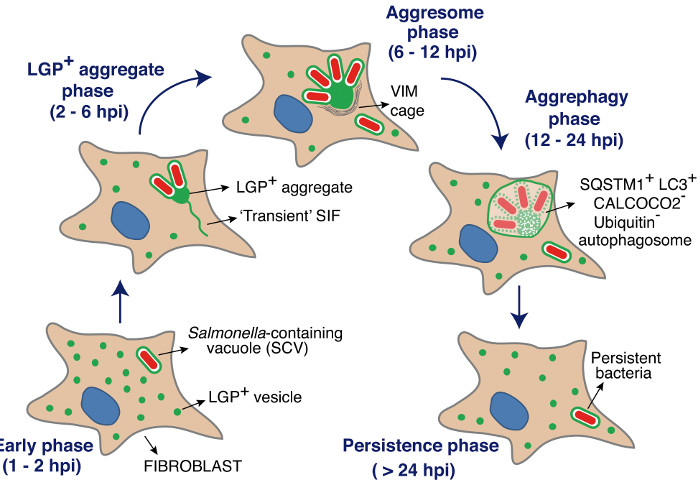A recent study found that Salmonella -an intracellular bacterial pathogen that infects humans- promotes the elimination of some of the bacteria inside the eukaryotic cell taking advantage of a process called aggrephagy. This way, the pathogen effectively controls the size of its progeny. This mechanism prevents the death of the host cell by an excessive number of bacteria inside it and promotes persistent infection over time.
Scientists at the Centro Nacional de Biotecnología of the CSIC (CNB-CSIC) have identified a new mechanism that allows Salmonella (bacteria causing food poisoning known as salmonellosis) control the size of its population within eukaryotic cells. This control is important to prevent the death of the host cell and establish a persistent infection in time.
To limit the growth of their offspring and ensure the continuity of intracellular infection, the bacteria themselves take advantage of a process called aggrephagy (type of selective autophagy that eliminates protein aggregates useless to the cell) which culminates with the sacrifice of only some members of its progeny. The study has been recently published in the journal Autophagy.
In this work, researchers have used real time microscopy to analyze he infection of living human cells exposed to intracellular pathogen Salmonella enterica serovar Typhimurium (S. Typhimurium).
According to their observations, S. Typhimurium promotes the accumulation of endomembrane aggregates inside the infected cell. To get rid of them, the cell induces a process of selective autophagy by aggrephagy intended to digest and eliminate these membranes aggregates inside a compartment called autophagosomes. "During this cleaning process, some nearby bacteria are also trapped inside the autophagosome and are also eliminated” explains Garcia del Portillo, principal author of the study and researcher at the CNB-CSIC.
The images of living cells obtained by the researchers show what happens inside the cell at all times throughout the infection. "The real time microscopy images show some of the bacteria being captured and digested by the machinery of aggrephagy while others try to escape. It seems a race against the clock to avoid being caught in the autophagosome once it has been sealed", add the researcher
According to the authors of the study, this is the first example of a phenomenon of simultaneous autophagy of bacteria and membrane aggregates from the host cell. "It's a very effective way to establish a persistent infection by manipulation of the autophagy machinery of the eukaryotic cell", concludes Garcia del Portillo.
.

Model showing how agrephagy of the host's membranes is exploited by S. Typhimurium to control bacterial progeny and establish a persistent intracellular infection / F. García del Portillo, CNB-CSIC
Upper image: Cell infected by S. Typhimurium. Salmonella bacteria in red, membrane aggregates in purple, vimentin surrounding aggresome in green, and nucleus in blue F. García del Portillo, CNB-CSIC